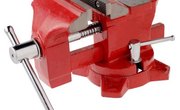Remington's Nylon 66 rifle was the first mass-produced firearm to contain synthetic materials. Manufactured from 1959 to 1991, its stock and receiver were made of "modern" Dupont Zytel 101 nylon. Over 700,000 units were sold, making it Remington's best-selling .22 caliber rifle. The Nylon 66 featured a blowback operated, semi-automatic action that received .22 long rifle ammunition from a 14-round tubular magazine. The rifle was 38.5 inches long and a super lightweight 4 pounds.
Items you will need
Gun cleaning patches
Gun cleaning oil
Gun cleaning rod
Gun cleaning solvent
Bristle brush
Phillips screwdriver
Cleaning Procedure
Make sure the gun is not loaded.
Use gun cleaning patches wetted with gun cleaning solvent and a .22 caliber cleaning rod to swab the bore until patches come out without any discoloration. Use a bristle brush if necessary on the cleaning rod to remove powder deposits.
Run a gun cleaning patch wetted with gun oil through the bore to lightly lubricate the barrel.
Cock the rifle and put the safety in the "Safe" position.
Pull out the bolt handle, remove the receiver cover screws and remove the receiver cover.
Pull the receiver assembly forward, then up and out of the rifle. Pull the bolt assembly back and hold it open.
Use gun cleaning patches wet with gun cleaning solvent to clean powder residue from the cartridge feed guide and the bolt rails.
Clean residue from the bolt face with gun cleaning patches wet with gun cleaning solvent.
Reassemble the rifle.
Warnings
- Remington considered nylon components of the Nylon 66 to be "self-lubricating." Routine oiling of the rifle's components other than the barrel bore was not recommended by Remington.
References
Warnings
- Remington considered nylon components of the Nylon 66 to be "self-lubricating." Routine oiling of the rifle's components other than the barrel bore was not recommended by Remington.
Writer Bio
Gus Stephens has written about aviation, automotive and home technology for 15 years. His articles have appeared in major print outlets such as "Popular Mechanics" and "Invention & Technology." Along the way, Gus earned a Bachelor of Arts in communications. If it flies, drives or just sits on your desk and blinks, he's probably fixed it.



